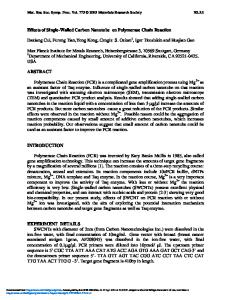Single Walled Carbon Nanotube Assisted Thermal Sensor
- PDF / 613,825 Bytes
- 6 Pages / 612 x 792 pts (letter) Page_size
- 82 Downloads / 358 Views
Single Walled Carbon Nanotube Assisted Thermal Sensor S. Chandrasekar2, K.S.V. Santhanam*1, Y. Yue1, K. Kalaiazagan2 and L. Fuller2 1. School of chemistry and materials science and 2. Electrical engineering and microelectronics Rochester institute of technology, rochester, ny 14623 *Corresponding author:[email protected] ABSTRACT A nano thermal sensor was made by depositing carbon nanotubes from a medium containing a) methylene chloride b)sodium dodecyl sulfate and c) Baytron-P (polymer) assisted sodium dodecyl sulfate. The nano thermal sensors showed d.c. electrical resistance as independent of temperature when the sensors were made by procedures (a) or (b). The electrical resistivity in both the situations has been independent of temperature. When the nanosensor is made with carbon nanotubes by assisted method (c), the d.c. electrical resistance decreased with temperature. The negative temperature coefficient (TCR) is manifested in the semiconducting property of the active material. The sensor behavior is reproducible and varies linearly with temperature. The nanosensor made by non assisted carbon nanotube showed zero TCR. This is probably the first instance of assisted thermal sensor made with single walled carbon nanotubes. INTRODUCTION The carbon nanotube structure has fascinated a number of investigators for the last several years in discovering its properties that would be functional in technological applications (1-2). The carbon nanotubes have been shown to have a very good thermal conductivity with the result this property has been utilized in thermo mechanical storage (3), scanning thermal microscopy (4,5), atomic force microscope cantilevers (6) and in a large number of thermal managements (7-10). Besides the above examples, the thermal conductivity of carbon nanotubes are finding a large number of electronic applications using the inherent electrical conductivity. However, there are very few or none that employ the carbon nanotubes as a sensor for temperature changes. The electrical resistance of single walled carbon nanotubes (SWNTs) have been discussed in the literature (11-13) from technological perspectives. The measurement of the resistance is done with pre-fabricated nanotubes by using a four probe technique. Among other methods used are conductive atomic force microscopy (14) and Kelvin force microscopy (15). The electrical resistance reported in the literature ranges from several kilo ohms to mega ohms (16). For this reason there have been very few sensors developed for the temperature measurements. In this paper, we wish to report the thermal effect on the inherent electrical conductivity of the single walled carbon nanotube deposited onto silicon chip sensor between two lithographically deposited gold electrodes under different chemical environments; here we observed that Baytron-P environment changes the carbon nanotube behavior to a semiconductor with a negative TCR.
EXPERIMENTAL Chemicals: Single walled carbon nanotubes were procured from Helix Material solutions Inc. (Richardson, Texas) and
Data Loading...











